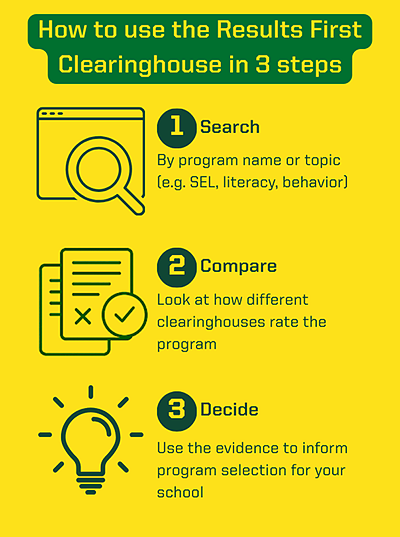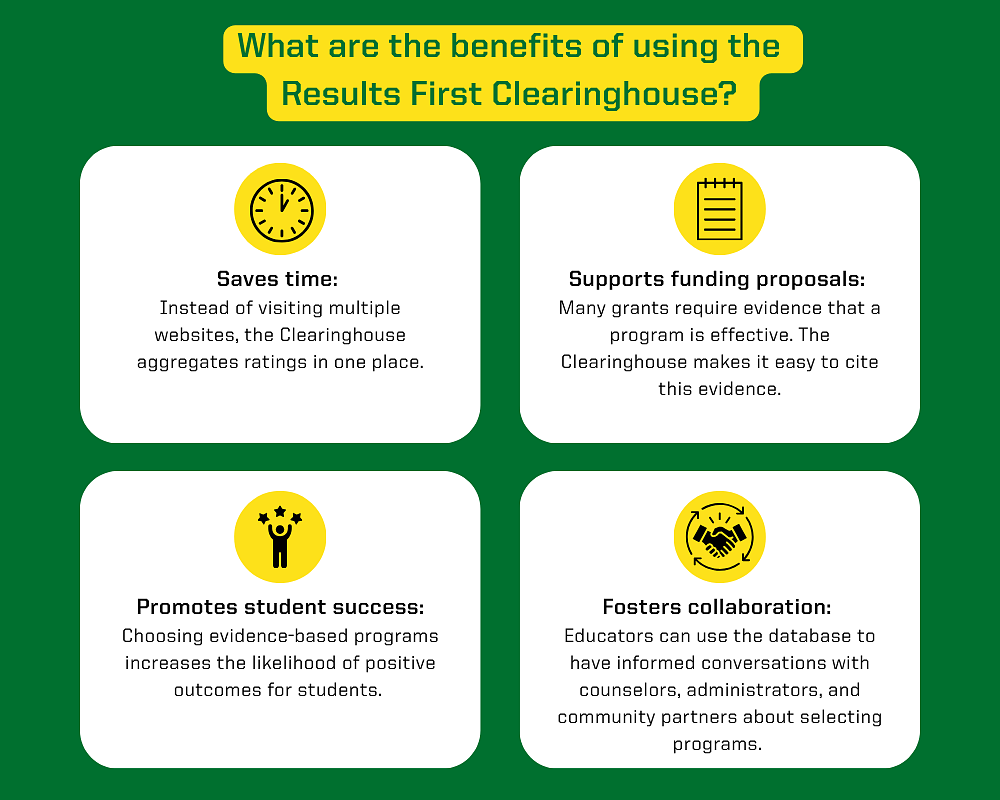By Patrick O'Neill, Doctoral Candidate in Human Development and Family Studies, T32 Predoctoral Fellow, Pennsylvania State University
The Results First Clearinghouse is a free online database created to help decisionmakers quickly find and compare evidence.
This free online database was created to help decisionmakers quickly find and compare evidence on programs in areas including education, mental health, child welfare, and juvenile justice. Instead of combing through multiple websites, the Results First Clearinghouse brings together ratings from multiple trusted sources into one easy-to-navigate location.
Here, I’ll discuss how the Results First Clearinghouse works and how educators can use it to make evidence-informed decisions that improve outcomes for students.
What is the Results First Clearinghouse?
Results First was originally developed by The Pew Charitable Trusts to help state and local governments invest in programs backed by strong evidence. Today, it’s maintained by the Evidence-to-Impact Collaborative at Penn State University, where it continues to serve as a user-friendly tool for accessing research on programs that work in various fields impacting children and families.1,2 The database doesn’t conduct its own research itself. Instead, it pulls ratings from several well-established evidence clearinghouses, including:
- What Works Clearinghouse (WWC) – Focused on educational programs
- Blueprints for Healthy Youth Development – Focused on youth development and prevention
- CrimeSolutions.gov – Focused on criminal justice and juvenile justice
- The California Evidence-Based Clearinghouse for Child Welfare (CEBC) – Focused on child welfare interventions
By combining these sources, it allows users to see how different social programs are rated across multiple different evidence reviews.

How can educators use it?
Educators and school leaders often need to select programs in areas like academic interventions (e.g., reading and math support), social-emotional learning, behavioral and mental health support, and violence or substance use prevention. The Results First Clearinghouse can help answer questions like:
- Is this program backed by strong evidence?
- Has it been shown to work with students like mine?
- Are there better-supported alternatives?
Step 1: Search by Topic or Program Name. The website lets you search by program name or filter by topic. For example, searching for “Check & Connect,” a popular dropout prevention program, reveals it has a “promising” rating from Blueprints for Healthy Youth Development.3
Step 2: Compare Evidence Across Sources. Because a program might be rated differently by different clearinghouses, it gives educators a more complete picture of the program. For example, a literacy intervention might be rated as “Effective” by one source, but “Mixed Evidence” by another, depending on how studies were evaluated.
Step 3: Make an Informed Decision. While the Clearinghouse doesn’t make decisions for you, it empowers you with trustworthy information. It can guide conversations with district leaders, inform grant applications, or help select interventions that are more likely to produce positive outcomes for students.
What are the benefits of the Results First Clearinghouse for educators?
- Saves time: Instead of visiting multiple websites, the Clearinghouse aggregates ratings in one place.
- Supports funding proposals: Many grants require evidence that a program is effective. The Clearinghouse makes it easy to cite this evidence.
- Promotes student success: Choosing evidence-based programs increases the likelihood of positive outcomes for students.
- Fosters collaboration: Educators can use the database to have informed conversations with counselors, administrators, and community partners about selecting programs.

Where to start?
You can explore the Results First Clearinghouse for free at resultsfirstclearinghouse.org/. For information on specific academic interventions, you can also explore the What Works Clearinghouse, which is one of the sources included in the Results First Clearinghouse that provides a deeper dive into educational research.
A cautious note on interpreting the ratings
It’s important to remember a program’s rating reflects how strong the research evidence is, not necessarily whether it will work in every context. Factors like student demographics, how well the program is implemented, and available resources all play a role. The database also provides clear definitions of each rating category in case there is any unfamiliarity with the language used. More information on the rating system can be found at the bottom of the Results First Clearinghouse webpage under the "Rating Colors & Systems" tab.
References
- VanLandingham G, Silloway T. Bridging the Gap between Evidence and Policy Makers: A Case Study of the Pew-MacArthur Results First Initiative. Public Adm Rev. [American Society for Public Administration, Wiley]; 2016;76(4):542–546.
- Results First: Clearinghouse Database [Internet]. Evidence-to-Impact Collaborative. [cited 2025 Mar 2]. Available from: https://evidence2impact.psu.edu/results-first-resources/clearing-house-…
- Blueprints for Healthy Youth Development – Committed to Healthy Youth, Families and Communities [Internet]. [cited 2025 Jun 29]. Available from: https://www.blueprintsprograms.org/
Want more from the HEDCO Institute: Sign up for our emails!
HEDCO Institute article 26 - November 12, 2025

